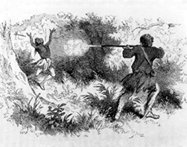Lessons of Ia Drang
"We Were Soldiers" (2002), Battle of Ia Drang, History, Strategy, Vietnam War

Major Bruce Crandall’s UH-1D in the background.
Larry Kummer, at Fabius Maximus, identifies the lessons the leadership of both sides learned from the early Vietnam War Battle of Ia Drang (famously depicted in the Mel Gibson movie “We Were Soldiers” [2002]). Only one side’s leadership got the lesson right.
On 14 November 1965 the 1st Cavalry Division (Airmobile) flew to the Ia Drang Valley of Vietnam, initiating the first major battle between the North Vietnamese and American armies. This marked our transition from advisers to direct combatants. There were two battles. One at Landing Zone X-Ray, where Americans under the command of Lt. Colonel Harold G. Moore (Lt. General, US Army, deceased) withstood fantastic odds – inflicted absurdly disproportionate casualties (with the aid of airpower and artillery), and withdrew. One at Landing Zone Albany, where Lt. Colonel Robert McDade made a series of basic mistakes that led to his unit being mauled. …
Ia Drang tested the new concept of air assault, in which helicopters inserted troops to a distant battlefield, then supplied and extracted them. During that four day “test†234 American men died, “more Americans than were killed in any regiment, North or South, at the Battle of Gettysburg, and far more than were killed in combat in the entire Persian Gulf War.†Both sides drew optimistic conclusions from the result.
We believed that our combination of innovative technology and tactics could achieve the victory that eluded France. We saw Ia Drang as a tactical success that validated our new methods, and so we expanded the war. We absurdly believed the victory resulted from our technology, not the valor and skill of our troops.
“In Saigon, the American commander in Vietnam, Gen William C. Westmoreland, and his principal deputy, Gen William DePuy, looked at the statistics of the 34-day Ia Drang campaign … and saw a kill ratio of 12 North Vietnamese to one American. What that said …was that they could bleed the enemy to death over the long haul, with a strategy of attrition.â€
North Vietnam’s leaders drew the opposite conclusions.
“In Hanoi, President Ho Chi Ming and his lieutenants considered the outcome in the Ia Drang and were serenely confident. Their peasant soldiers had withstood the terrible high-tech firestorm delivered against them by a superpower and had at least fought the Americas to a draw. By their yardstick, a draw against such a powerful opponent was the equivalent of a victory. In time, they were certain, the patience and perseverance that had worn down the French colonialists would also wear down the Americans.â€
Also, North Vietnam’s leaders believed that US commanders would more often be like McDade than Moore. The next decade proved that they were correct. General Võ Nguyên Giáp understand the significance of this battle, and that the war would evolved as he had explained in 1950 to the political commissars of the 316th Division (then discussing France, but eventually true of America as well — in Vietnam as well as our post-9/11 wars)…
“The enemy will pass slowly from the offensive to the defensive. The blitzkrieg will transform itself into a war of long duration. Thus, the enemy will be caught in a dilemma: he has to drag out the war in order to win it and does not possess, on the other hand, the psychological and political means to fight a long drawn-out war.â€
— From Bernard Fall’s Street without joy: Indochina at war, 1946-54 (1961).
—————————-
Deleted scene from “We Were Soldiers” (2002)




